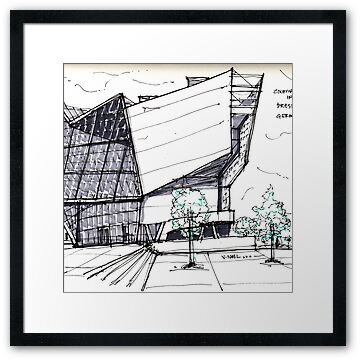This is a sketch of the Shore Temple (Mamallapuram) in Tamil Nadu (previously called Chennai), south India. Standing in front of the temple is a woman with her orange sari dancing in the ocean breeze. I went to Tamil Nadu (Chennai) in October 2008 to spend Divali with my friend, Harish. He is originally from Chennai and was going home from DC for vacation. I left Ahmedabad, along with my housemates who were also originally from there and were heading home. I was bound with bright-eyes and bushy tail to Chennai. Harish and his family (hello Appa) were the perfect hosts for my entire stay. His dad who I affectionately also called “appa” made sure I was always well fed. He always had a snack of some sort for me. One of the many places Harish took me was Mamallapuram. It was beautiful…the beach was too! As one of the Group of Monuments at Mamallapuram, the Shore Temple has been classified as a UNESCO World Heritage Site. Thanks Harish & Appa!
Here is a bit more about the Shore Temple and Mamallapuram below:
The Shore Temple, is erected on the beach not far from the great relief of the Descent of the Ganges. The temple was planned in such a way that the door of the sanctuary opened to the east, in order to catch the first rays of the rising sun. This in itself resulted in a rather peculiar arrangement, since it necessitated the placing of the maṅḍapa and the temple court at the rear or west end of the main sanctuary. The terraced spires crowning both shrine and porch very clearly reveal a development from the form of the Dharmarāja rath. In the Shore Temple, however, the dependence on the vihāra type is less marked, owing to the new emphasis on the height and slenderness of the tower, like an attenuated version of the Dharmarāja rath. Actually, the characteristic Dravidian form of a terraced structure with the shape of the terminal stūpika echoed in lesser replicas on the successive terraces still prevails, but these recessions are so ordered as to stress the verticality of the structure as a whole. Such hallmarks of the Pallava style as the pilasters with the rampant lions persist in the decoration of the façade of this structural monument.

Shore Temple - Tamil Nadu, India
From the Māmalla Period there date the remarkable rock-cut temples of Māmallapuram or ‘Seven Pagodas’ on the sea-coast below Madras. The work here was under the patronage of the king, Narasiḿha. The principal architectural monuments consisted of five temples or raths that are really free-standing sculptural replicas of contemporary structural buildings carved from the granolitic outcrops on the shore. These monuments are of the greatest importance for the later development of Dravidian architecture because they reveal the dependence of the later Hindu style on pre-existing types of Buddhist architecture. Especially revealing for this latter aspect of the style is the Dharmarāja rath. It has a square ground storey with open verandahs, which forms the base of the terraced pyramidal śikhara above. It has been rightly suggested that this typical Dravidian form is an adaptation of a Buddhist vihāra, in which successive storeys were added for the accommodation of the monks. The terminal member of the structure is a bulbous stūpika, which is repeated in smaller scale on each of the lower levels of the terraced superstructure. Perhaps the most distinctive feature of this and the other raths at Māmallapuram lies in the open verandahs on the ground-storey. The pillars are of a distinctive Pallava type with the shafts of the columns supported by the bodies of seated lions.
Reference: The Art and Architecture of India: Buddhist, Hindu, Jain by Benjamin Rowland
Smile…

This work by Vernelle Noel is licensed under a Creative Commons Attribution-NonCommercial-NoDerivs 3.0 Unported License.









